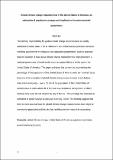Global climate change responsiveness in the USA : an estimation of population coverage and implications for environmental accountants
Abstract
The primary responsibility for global climate change responsiveness is usually attributed to nation states. This is reflected in the United Nations’ processes aimed at enrolling governments in mitigation and adaptation programmes. Such an approach begs the question of how global climate change (GCC) responsiveness might proceed if a national government is hostile to the issue, as appears likely to be the case in the USA. This paper addresses this concern by documenting the percentage of the population of the USA who are ‘covered’ by at least one of six examples of GCC responsiveness at sub-federal – state and municipality – levels. Of the population of the USA, 25.8% lives in states where all of the state-level initiatives surveyed are in effect, whereas only 4.4% are not covered by any of the six. This coverage has increased as compared to earlier surveys (Lutsey, N., and D. Sperling. 2008. “America’s Bottom-Up Climate Change Mitigation Policy.” Energy Policy 36: 673–685. doi:10.1016/j.enpol.2007.10.018). This finding suggests that there is more practical hope for GCC responsiveness than might be commonly appreciated and this also has ramifications for research in accounting.
Citation
Bebbington , J & Harrison , J 2017 , ' Global climate change responsiveness in the USA : an estimation of population coverage and implications for environmental accountants ' , Social and Environmental Accountability Journal , vol. 37 , no. 2 , pp. 137-143 . https://doi.org/10.1080/0969160X.2017.1300101
Publication
Social and Environmental Accountability Journal
Status
Peer reviewed
ISSN
0969-160XType
Journal article
Collections
Items in the St Andrews Research Repository are protected by copyright, with all rights reserved, unless otherwise indicated.

